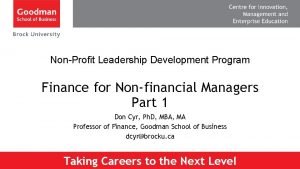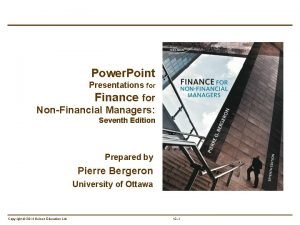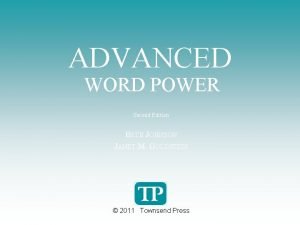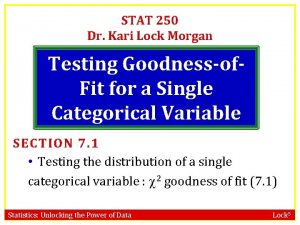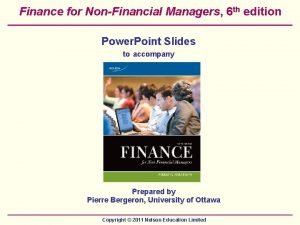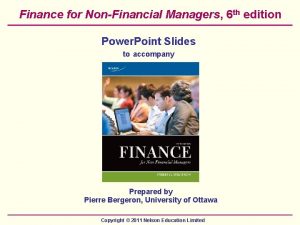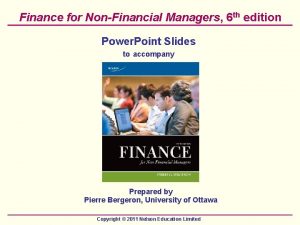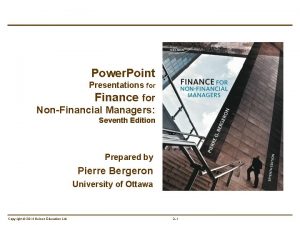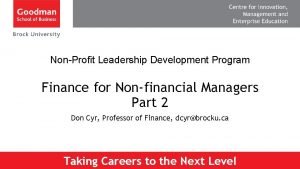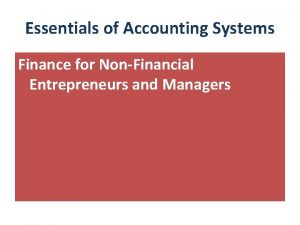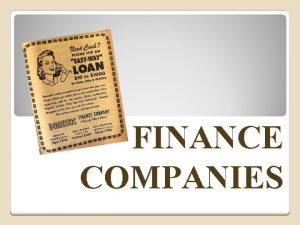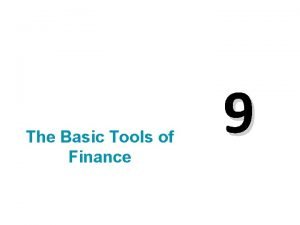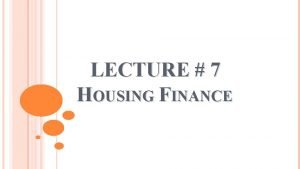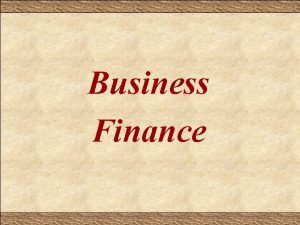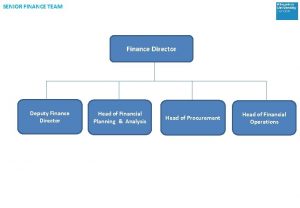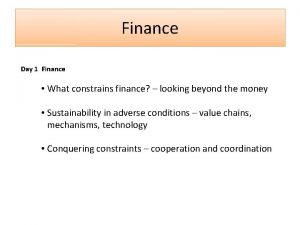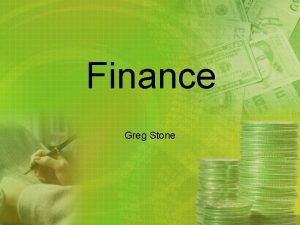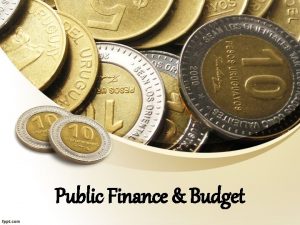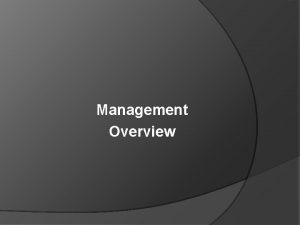Finance for NonFinancial Managers 6 th edition Power
































- Slides: 32

Finance for Non-Financial Managers, 6 th edition Power. Point Slides to accompany Prepared by Pierre Bergeron, University of Ottawa Copyright © 2011 Nelson Education Limited

Finance for Non-Financial Managers, 6 th edition CHAPTER 2 ACCOUNTING AND FINANCIAL STATEMENTS Copyright © 2011 Nelson Education Limited

Accounting and Financial Statements Chapter Objectives 1. Explain the activities related to bookkeeping. 2. Describe the accounting function and give an outline of the four financial statements. 3. Explain the contents and the structure of the statement of income, the statement of changes in equity and the statement of financial position. 4. Explain the meaning of analysis in financial management. 5. Discuss the importance of decision-making in financial management. 6. Draw a comparison between the GAAP and IFRS financial statements’ presentation format. 7. Explain the contents and structure of financial statements prepared for not-for-profit organizations. Chapter Reference Chapter 2: Accounting and Financial Statements Copyright © 2011 Nelson Education Limited

Financial Management Includes Bookkeeping Accounting Financial Statements Copyright © 2011 Nelson Education Limited

1. Bookkeeping As a rule, when all accounts are closed at the end of an accounting period, the asset and expense accounts have debit balances and the equity, liability and revenue accounts have credit balances. Debit Statement of Financial Position Accounts Assets Credit Equity Liabilities Debit Statement of Income Accounts Expenses Revenue Transfer (profit for the year) is made at the end of the accounting period Copyright © 2011 Nelson Education Limited Credit

The Accounting Equation Statement of Financial Position A = E + L Statement of Income R - E Debit Increases Decreases Increases Credit Decreases Increases Profit for the year Ends with the Trial Balance Statement of changes in equity Debits = Credits Copyright © 2011 Nelson Education Limited Profit

The Accounting Cycle Business Activity is recorded in Activity is transferred to Transaction Document Journals Ledgers takes place is prepared Statement of Financial Position 1. Cash account 3. House 2. VISA 4. Car Statement of Income 1. Salary 3. Rent 2. Food 4. Clothing Copyright © 2011 Nelson Education Limited

The Trial Balance (Wiley Inc. Dec. 31, 2010) Debit Credit SFP $25, 000 ______ Cash and cash equivalents SI $500, 000 ______ Revenue Finance costs SFP 20, 000 ______ SI 10, 000 ______ Cost of sales SI 300, 000 ______ Prepaid expenses SFP 50, 000 ______ Short-term borrowings SCE 135, 000 ______ Retained earnings (beginning of year) SFP 100, 000 ______ Trade receivables SFP 15, 000 ______ Accrued expenses Distribution costs SI 50, 000 ______ Income tax expense SI 25, 000 ______ Current income taxes payable 2, 000 ______ SFP Future income taxes payable (deferred taxes) SFP 3, 000 ______ SFP 200, 000 ______ Long-term borrowings Inventories SFP 200, 000 ______ SFP 100, 000 ______ Trade and other payables SFP 20, 000 ______ Current portion of long-term debt Copyright © 2011 Nelson Education Limited Administrative expenses 50, 000 Non-current assets (at cost) Depreciation SI ______ SFP 500, 000 ______ SI 25, 000 ______ SFP 100, 000 ______ Accumulated depreciation Dividends SCE 20, 000 ______ SFP 200, 000 ______ Share capital Total $ 1, 325, 000 Copyright © 2011 Nelson Education Limited

Accrued Expenses Represent a bill which the company stills owes during the current operating year (i. e. , wages, rent, bonus, federal, provincial, or municipal taxes). Dec. 24 Dec. 31 An employee works for a week without being paid for $800 So, the company owes $800 (liability) to the employee when the books are closed Copyright © 2011 Nelson Education Limited Jan. 7

Prepaid Expenses Payments made on accounts for which services have not yet been provided (i. e. , rent, insurance, office supplies, property taxes). June 30 December 31 Pay $4, 000 for insurance this year and show $2, 000 as an expense… …but, will also show in the closing statement of financial position an amount of $2, 000 (asset) as a prepaid expense. Copyright © 2011 Nelson Education Limited June 30

2. Financial Statements To determine the value or wealth of a business, look at the STATEMENT OF FINANCIAL POSITION (also known as the balance sheet) since it gives a reading of its financial position at a given point in time; it’s like a snapshot or an X-Ray. To determine the flow or wealth of a business, look at the STATEMENT OF INCOME (also known as the earnings statement, the statement of operations and the profit and loss statement) since it shows the infusion of revenue and expenses between two accounting periods. To determine the accumulated wealth of a business, look at the STATEMENT OF CHANGES IN EQUITY (statement of retained earnings section) since it shows the amount paid to the shareholders and the amount retained in the business. Copyright © 2011 Nelson Education Limited

3. Financial Statements - Structure and Contents Statement of Income Statement of Retained Earnings Revenue Retained earnings (beginning) $900, 000 Cost of sales Earnings for the year Gross profit Less: dividends Other income/expenses Retained earnings (ending) Profit for the year $100, 000 Statement of Financial Position Assets Equity $80, 000 • Non. Liabilities current $230, 000 • Long-term $150, 000 • Current $25, 000 $100, 000 $ (20, 000) $ 80, 000 $980, 000 Statement of Cash Flows • Sources of funds (Where they come from) $100, 000 $25, 000 $150, 000 Profit CL LT • Uses of funds (Where they went) $20, 000 $230, 000 $25, 000 Div. NCA CA Copyright © 2011 Nelson Education Limited

Statement of Income (Operating Performance) Revenue Cost of sales 1 Gross profit Other income Distribution costs Administrative expenses Finance costs Total other income and costs 2 Profit before taxes Income tax expense 3 Profit for the year Copyright © 2011 Nelson Education Limited

Statement of Comprehensive Income Profit for the year Other comprehensive income/(loss) Exchange differences on translating foreign operations Gain or loss on property revaluation Actual gains (losses) on defined benefit pension plans Total other comprehensive income/(loss) for the year 4 Total comprehensive income Copyright © 2011 Nelson Education Limited

Wiley’s Financial Statements Wiley Inc. Statement of Income for the Period Ending December 31, 2010 1 Revenue $500, 000 Cost of sales Gross profit (300, 000) 200, 000 ($50, 000) Distribution costs 2 3 Income tax expense Profit for the year $ 25, 000 $ 40, 000 $ 65, 000 (25, 000) Total operating expenses Operating income (E B I T) Finance costs Profit before taxes Cash flow (50, 000) Administrative expenses Depreciation (125, 000) 75, 000 (10, 000) $75, 000 25, 000 65, 000 (25, 000) $40, 000 EBITDA $100, 000 Wiley Inc. Statement of Retained Earnings as at December 31, 2010 Retained earnings (beginning of year) Earnings for the current year Dividends $ 135, 000 $ 40, 000 (20, 000) Retained earnings (end of year) 20, 000 $ 155, 000 Copyright © 2011 Nelson Education Limited

Wiley’s Financial Statements $40, 000 Profit for the year Other comprehensive income/(loss) --- Exchange differences on translating foreign operations Gain or loss on property revaluation ----- Actual gains (losses) on defined benefit pension plans --- Total other comprehensive income/(loss) for the year --- 4 Total comprehensive income $40, 000 Copyright © 2011 Nelson Education Limited

Wiley’s Financial Statements Wiley Inc. Statement of Changes in Equity for the Period Ending December 31 2010 2009 $185, 000 $180, 000 15, 000 • Dividend reinvestment and share purchase plan --- • Share issued on exercise of stock options --- $200, 000 $185, 000 Balance at beginning of year --- • Stock based compensation --- • Options exercised --- Balance at end of year --- $135, 000 $125, 000 40, 000 20, 000 (20, 000) (10, 000) $155, 000 $135, 000 Balance at beginning of year --- • Change in currency translation --- • Change in property revaluation --- Balance at end of year --- Share capital Balance at beginning of year • Common shares issued Balance at end of year Contributed surplus Retained earnings Balance at beginning of year • Earnings for the year • Dividends paid to shareholders Balance at end of year Total other comprehensive/(loss) for the year Copyright © 2011 Nelson Education Limited

Statement of Financial Position (Financial Structure) Non-Current Assets Equity Long-term borrowings • Capital budgeting • Financial leverage • Cost of financing • Cost of capital Current Assets Current Liabilities Working capital Copyright © 2011 Nelson Education Limited

Wiley’s Financial Statements Wiley’s Inc. Statement of Financial Position as at December 31, 2010 1 Non-current assets $500, 000 • Accumulated depreciation (100, 000) $400, 000 Current assets 2 • Inventories 200, 000 • Trade receivables 100, 000 • Prepaid expenses 20, 000 • Cash and cash equivalents 25, 000 345, 000 Total current assets $745, 000 Total assets 3 • Share capital 200, 000 • Retained earnings 155, 000 355, 000 Total equity • Long-term borrowings 4 200, 000 • Future income taxes payable 3, 000 Total non-current liabilities 203, 000 Current liabilities 100, 000 • Trade and other payables 5 • Short-term borrowings 50, 000 • Accrued expenses 15, 000 • Current portion of long-term debt 20, 000 • Current income taxes payable 2, 000 187, 000 Total current liabilities $745, 000 Total equity and liabilities Copyright © 2011 Nelson Education Limited

Taxation, Depreciation and Capital Cost Allowance 1. Corporate tax rate (varies from province to province) 2. Taxation for small businesses (if taxable profit is less than $400, 000 they benefit from a 25% small business deduction) 3. Business expenses and deductions • Operating expenses (i. e. , cost of sales, operating expenses) • Financing costs (interest on debt) • Business losses (carried over in future years) • Capital cost allowance (Canada Revenue Agency) Depreciation Copyright © 2011 Nelson Education Limited

Depreciation (non-current assets) A $100, 000 asset with a 5 -year life span. Revenue $ 200, 000 Expenses Depreciation 20, 000 Other expenses 160, 000 • It is an accounting entry. Total expenses 180, 000 • It represents the loss in value of an asset Profit before taxes 20, 000 Income tax expense 10, 000 Profit for the year Add back depreciation 10, 000 20, 000 Cash flow $ 30, 000 • Goodwill Amortization • Patents • Franchise • Trademarks • Legal and architectural fees • Research and development due to wear and tear. • The cost of the asset is spread against revenue; it is more realistic. • It is sometimes referred to as “reserve for depreciation” (accumulated). (intangible assets) These costs can also be capitalized and amortized over a period of time (years) just like amortization for capital assets. Copyright © 2011 Nelson Education Limited

CCA and Depreciation CCA @ 50% Declining Depreciation Straight line 1 $100, 000 @ 50% $25, 000* $ 20, 000 2 75, 000 @ 50% $37, 500 20, 000 3 37, 500 @ 50% $18, 750 20, 000 4 18, 750 @ 50% $ 9, 375 20, 000 5 9, 375 @ 50% $ 4, 687 20, 000 * Income tax regulations allow only half of the CCA rate during the first year. Copyright © 2011 Nelson Education Limited

Income Statement and P&L Statement P&L statement Accountant’s worksheet Statement of income $300, 000 Cost of sales 150, 000 Gross profit 150, 000 Operating expenses 50, 000 CCA/Depreciation 25, 000 20, 000 Total expenses 75, 000 70, 000 Profit before taxes 75, 000 80, 000 Taxes - Current (50%) 37, 500 40, 000 Future 2, 500 40, 000 $35, 000 $40, 000 Year 1 Revenue Profit for the year *The company paid $2, 500 less in taxes due to higher CCA rate. Therefore, the company owes this amount to the government in the form of future income taxes payable (it’s like an interest free loan). Copyright © 2011 Nelson Education Limited

Future Income Taxes Payable (Deferred Taxes) Depreciation Difference @ 20% between CCA @ & depreciation Years 50% Difference in annual future cumulative income taxes @ future 50% income taxes 1 $25, 000 $ 20, 000 $ 5, 000 $ 2, 500 2 $37, 500 $ 20, 000 $17, 500 3 $18, 750 $ 20, 000 - $ 1, 250 -$ 625 $ 10, 625 4 $ 9, 375 $ 20, 000 - $ 10, 625 - $ 5, 312 $ 5, 313 5 $ 4, 687 $ 20, 000 - $ 15, 313 - $ 7, 656 $ 2, 500 $ 8, 750 Copyright © 2011 Nelson Education Limited $ 11, 250 -----

The Auditor’s Report Canadian corporate law requires that every limited company appoint an auditor to represent shareholders and report to them annually on the company’s financial statements, expressing an opinion in writing as to their: • fairness, and • consistency. In Canada, the auditor’s report conventionally has two paragraphs: 1. Scope of the examination (accounting procedures in use and tests of the accounting records); 2. Auditor’s opinion on the statements indicating that the financial statements present fairly the financial position of the company in accordance with Generally Accepted Accounting Principles (GAAP) applied on a basis consistent with that of the preceding year. Copyright © 2011 Nelson Education Limited

Accounting for Inflation and Changing Values A. Need Question the validity of traditional accounting practices. Do financial statements prepared according to traditional accounting principles present fairly the financial position of a company in periods of inflation? B. Suggested Solutions 1. Price level accounting Restating all figures in financial statements in terms of current purchasing power. 2. Current value accounting What it would currently cost to acquire an asset with the same capability or capacity as the one presently owned. Current Canadian Practice In 1982, the recommendations call for Canadian enterprises whose securities are traded in a public market to disclose in their annual reports supplementary information on the effect of changing prices. Copyright © 2011 Nelson Education Limited

4. Financial Analysis • Horizontal analysis • Vertical analysis • Statement of cash flows • Ratio analysis • Break-even analysis • Leverage analysis • Risk analysis Copyright © 2011 Nelson Education Limited

5. Decision-Making • Financing decisions • Working capital decisions • Capital budgeting decisions • Growth decisions • Capital structure decisions • Lease or buy decisions • Pricing decisions • Operating budgeting decisions • Valuation decisions Copyright © 2011 Nelson Education Limited

6. Financial Statements – GAAP versus IFRS GAAP IFRS Income Statement of Income and Statement of Comprehensive Income Revenue Sales revenue Cost of sales 1 Gross profit Other income Operating expenses Selling expenses Distribution costs Administrative expenses Total operating expenses 2 Operating income (EBIT) Finance costs Total 2 Profit before taxes Other income Income tax expense Other expenses Extraordinary expenses 3 Profit for the year 3 Income before taxes Income taxes 4 Net income Total other comprehensive income/(loss) for the year 4 Total comprehensive income Copyright © 2011 Nelson Education Limited

Financial Statements – GAAP versus IFRS GAAP IFRS Balance Sheet Statement of Financial Position Assets Current assets Non-current assets Capital assets Intangible assets Current assets Total assets Liabilities Equity Current liabilities Long-term debts Liabilities Total liabilities Non-current liabilities Current liabilities Shareholders’ equity Total liabilities and equity Total equity and liabilities Copyright © 2011 Nelson Education Limited

Financial Statements – GAAP versus IFRS GAAP IFRS Statement of Changes in Equity Share capital • Preferred shares • Common shares • Contributed surplus • Retained earnings • Total other comprehensive Total shareholders’ equity income/(loss) for the year Total shareholders’ equity Copyright © 2011 Nelson Education Limited

7. Not-For-Profit Organizations Statement of Operations Revenue Less expenses Equals excess of revenues over expenses Statement of Changes in Net Assets Excess (deficiency) or revenue over expenses and net change in investment in capital assets Statement of Financial Position Assets minus liabilities equals net assets Statement of Cash Flows Operating activities Financing and investing activities Copyright © 2011 Nelson Education Limited
 Wharton finance for nonfinancial managers
Wharton finance for nonfinancial managers Finance for non-financial managers ppt
Finance for non-financial managers ppt Power triangle
Power triangle Chapter 8 personal finance
Chapter 8 personal finance Sujata madan
Sujata madan Corporate finance tenth edition
Corporate finance tenth edition Fundamentals of corporate finance third canadian edition
Fundamentals of corporate finance third canadian edition Fundamentals of corporate finance fifth edition
Fundamentals of corporate finance fifth edition Corporate finance 6th edition
Corporate finance 6th edition Corporate finance tenth edition
Corporate finance tenth edition Corporate finance tenth edition
Corporate finance tenth edition Corporate finance tenth edition
Corporate finance tenth edition Corporate finance tenth edition
Corporate finance tenth edition Using mis (10th edition) 10th edition
Using mis (10th edition) 10th edition Using mis (10th edition)
Using mis (10th edition) Advanced word power second edition answers
Advanced word power second edition answers Statistics: unlocking the power of data 1st edition
Statistics: unlocking the power of data 1st edition Science power 9 atlantic edition
Science power 9 atlantic edition Fspos vägledning för kontinuitetshantering
Fspos vägledning för kontinuitetshantering Typiska drag för en novell
Typiska drag för en novell Nationell inriktning för artificiell intelligens
Nationell inriktning för artificiell intelligens Returpilarna
Returpilarna Shingelfrisyren
Shingelfrisyren En lathund för arbete med kontinuitetshantering
En lathund för arbete med kontinuitetshantering Underlag för särskild löneskatt på pensionskostnader
Underlag för särskild löneskatt på pensionskostnader Personlig tidbok för yrkesförare
Personlig tidbok för yrkesförare Anatomi organ reproduksi
Anatomi organ reproduksi Densitet vatten
Densitet vatten Datorkunskap för nybörjare
Datorkunskap för nybörjare Tack för att ni lyssnade bild
Tack för att ni lyssnade bild Debatt mall
Debatt mall Magnetsjukhus
Magnetsjukhus Nyckelkompetenser för livslångt lärande
Nyckelkompetenser för livslångt lärande
